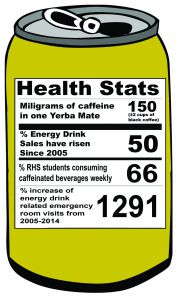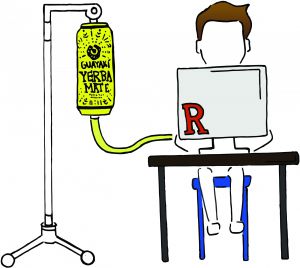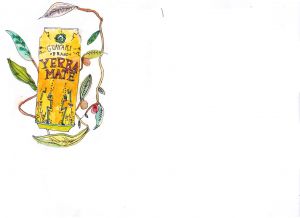A teenager’s best chemical friend
October 26, 2018
In the morning, it’s there to wake you up. It’s your morning pep talk. At times, it even accompanies you through long, boring lectures to keep you from dozing off. It motivates you to study for that big math test. When it’s not around, you grow irritable and your mind feels foggy. This is the relationship between caffeine and the average American teen.
Caffeine is a naturally occurring stimulant that activates the brain and nervous system, prompting a boost of energy and alertness. According to the University of Michigan, caffeine can lead to a rapid heartbeat, high blood pressure and diabetes. It can further aggravate existing health problems in teens such as heart disease and anxiety-related disorders. Caffeine creates hyperactivity in the brain, which often leads to neurological effects such as tremors and heightened stress.
Senior Caroline Soja experienced the extreme effects of caffeine consumption first hand. For approximately a month, Soja had sporadic and severe migraines, characterized by loss of vision in her left eye and a form of paralysis in her muscles. After a recent field hockey game, Soja’s migraines reached their height.
“Everyone thought I was having a stroke. My lip started chattering. I couldn’t move my top lip so I was slurring all my words,” Soja said. “I felt paralyzed and I couldn’t move my body.”
After a trip to the ER, she was diagnosed with hemiplegic migraines, a rare form of migraine with similar symptoms to that of a stroke, including paralysis, headache, nausea and impaired vision. According to the American Migraine Association, caffeine is a common trigger for various forms of migraines. Soja’s migraines were dormant until aggravated by heightened caffeine intake.
“I’m trying to manage college apps and maintain my grades. I’m also the captain for the field hockey team so I have to devote a lot of time to that, too,” Soja said. “I was drinking a lot of Yerba Mates to keep up with my schedule because I’ve been so tired.”
Soja said that caffeine is a stressor on the body, and warns teens to steer clear from abusing it.
Increased caffeine consumption can also be directly linked to sleep deprivation rates, according to Jonathan Hirsch, a psychology teacher with expertise on the developing teen brain.
“The whole issue of being sleep deprived is a relatively modern phenomenon. We haven’t evolved to deal with sleep deprivation. [Humans] haven’t evolved genes that tell us, ‘Stop what you’re doing and go to sleep,’” Hirsch said.
Sleep deprivation can leave the brain in a stressed state that can be exacerbated by caffeine consumption. Because of the stressors put on the brain, less blood flows to the frontal cortex and its growth is stunted.
The excessive consumption of caffeine can disrupt key connections in the brain between transmitters. During adolescence, while the brain is still forming and vulnerable, it has a large number of neural connections, which are rendered less efficient by caffeine.
Caffeine’s role in the lives of adolescents has evolved from a convenient aid to a functional necessity, as demonstrated by its usage among students. Sixty-six percent of Redwood students report consuming caffeinated beverages weekly, according to a recent self-reported Bark survey. This high level of consumption is compounded as caffeine is molded to fit the needs of our increasing high school workloads, according to Hirsch.
“As far as caffeine’s ability to create physical dependence, there is no debate there. If you’re drinking coffee or Yerba Mate every day you will develop a chemical dependency sooner or later,” Hirsch said.

Caffeinated beverages have grown in popularity among younger demographics. According to the National Institute of Health and Medicine, energy drink sales have risen by 50 percent since 2005, making it the fastest growing beverage industry. At Redwood, Guayaki Yerba Mate in particular has become a staple in the lives of many students. Due to its high volume of caffeine and mild taste, the drink has become an alternative for those who don’t enjoy the bitter flavor of coffee. Despite Guyaki’s all-natural marketing, Yerba Mate contains approximately 150 mg of caffeine, which is the equivalent to about two cups of black coffee.
Some students appreciate the convenience of caffeinated beverages when keeping up with the fast-paced day. With a busy schedule to upkeep, lost hours of sleep are often compensated with artificial sources of energy.
Junior Tatum Shaver finds herself dependent on caffeine.
“Sophomore year, I used to have a large can of Yerba Mate [and] a latte every day, and I would usually get a [caffeinated] drink at lunch,” Shaver said.
Shaver said that caffeine is a constant in her daily life and that it’s become a necessity for day-to-day tasks.
“Going to school without caffeine would be nearly impossible for me now because I’m so used to it and so dependent on it. If I go a day without caffeine, I’ll get a huge headache,” Shaver said.
The manner in which caffeinated beverages are marketed has evolved to cater to a younger audience. Packaging has developed into colorful cans featuring sports, video games, pop culture references and characters, designed to entice younger demographics. According to the National Council of Strength and Fitness, some marketing teams such as Spark, an energy drink company, have made the diameter of the can smaller to comfortably fit in a smaller grip. Plastered in bright purple letters across Spark’s website is their motto: “Transform your day, delivering energy and enhanced mental focus since 1994,” easily misinterpreted as a healthy source of convenient energy to boost workouts and increase mental efficiency.
According to Hirsch, marketing teams are largely aware of the importance of reaching young consumers.
“These companies, whether it’s Starbucks or Peet’s or whoever, know that whatever brand [teens] start drinking, you’re more likely to keep drinking for the next 25 to 50 years,” Hirsch said. “Absolutely they’re going to market to teenagers. From a purely marketing and economic point-of-view, they’d be stupid not to.”
Finding loopholes in loose regulations, energy drink companies, such as Monster, make the drinks appear deceivingly nutritional, labeling them as “zero calories” or “naturally flavored.”
“The ‘natural’ claim is misconceiving,” Hirsch said. “Opium is natural. Cyanide is natural. Natural is a highly overrated rationalization for the use of any substance. Natural does not mean we have evolved to metabolize it.”
The brain has not evolved to metabolize other substances, such as alcohol, and mixing it with caffeine has integrated into binge drinking culture. Caffeine enhances the effects of alcohol by suppressing its sedativity, which in turn prolongs intoxication and increases the risk of alcohol poisoning. According to Scientific American, alcohol and caffeine both interfere with dopamine production, a neurotransmitter responsible for pleasure and emotional response. This obstruction can temporarily mask the effects of alcohol.
According to Catherine Miller, a specialist in Adolescent Medicine working with clinics at Stanford and Michigan, mixing the substances can result in higher blood-alcohol levels, leading to serious health impacts. Miller said she’s alarmed by the number of alcohol and caffeine related incidents that have come through her hospital doors.
“I have seen caffeine use in patients high enough to necessitate consulting poison control. I’ve had to put patients in the hospital a few times because of caffeine-related cardiac or neurological toxicity,” Miller said.
According to the American Academy of Pediatrics, from 2005 to 2011, energy drink-related emergency room visits rose from 1,494 to 20,783.
As good of a “friend” as it may seem, caffeine dependence is a proven toxic relationship and the source of many health problems. Caffeine alters the brain’s chemistry so that we need it when it’s not around. It encourages bad decision-making by intensifying and prolonging the effects of alcohol. It manipulates us to be attracted to it with flashy first impressions. Caffeine is a drug that has nestled its way into our youth culture as a social norm.









